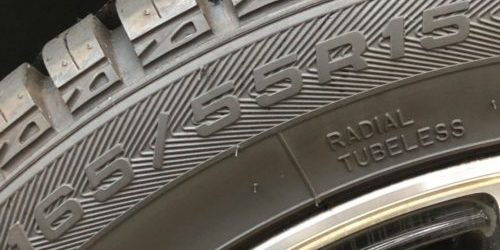Have you ever check your tire? Have you tried to figure out what your tire says? after reading this article, you would like to check your tires.
A car can run safely only if it has tires. Knowing about the tire is very important and also give you some advantages. To find out more about tires, let’s understand the meaning of the numbers and symbols engraved on the sidewall (side of the tire).
- 1.Check the basic specifications on the tire display
Tires made by elaborately combining materials such as rubber, wires, and fibers. It accurately conveys basic performance such as driving, turning, and stopping to the road surface and supports the load of the vehicle. It is important for the driver to know the tire specifications and conditions for a safe and enjoyable drive. Understand the meaning of the information displayed on the sidewall of the tire is the first key to drive safely. Let’s take a look at the information that is commonly displayed regardless of the manufacturer.
If you look at the sidewalls, you will be able to see the sequence of numbers in the large letters. A three-digit number starting with 1 or 2. Separated by “/” (slash), two digits.
Next, in most cases, the letter “R” is included, followed by the number of 10s or 20s. Leave a space around a corner and have a two-digit number and one letter. These markings are, from left to right, tire width (mm), flatness (%), radial, rim diameter (inch), load index (LI), and speed symbol. When explained in detail, each has the following meanings.
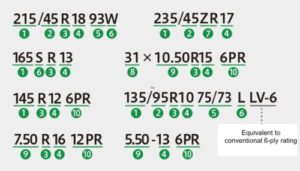
1. Tire width (MM)
2. Flatness
3. Radial structure
4. Rim diameter (inch)
5. Load Index (LI)
6. Speed symbol
7. Speed category
8. Tire outer diameter (inch)
9. Tire width (inch)
10. Tire strength (ply rating)
[Tire width]
Tire width. The cross-sectional width is the area excluding the slightly protruding parts such as the side wall characters and decorations.
[Flatness (%)]
A numerical value that represents the ratio of the sectional height to the tire sectional width The smaller, the smaller the height of the sidewalls makes thinner tire. As a result, stability is improved and handling responsiveness is improved, but it is said that the impact from the road surface is large because the sidewall is thin. On the other hand, if the flatness ratio is high, the absorption rate of the impact from the road surface is increased, so that the driving comfort tends to be improved. However, the sidewalls tend to bend, and sometimes the tires may feel like falling when turning corners.
[Radial]
It is a tire in which the carcass (the internal structure of the rubber that forms the skeleton of the tire) is woven at a right angle to the direction of travel, and almost all passenger car tires are radial tires, so almost always “R letter Is attached. If it is not a radial tire, it is a type of bias tire, and there are cases where it is not marked or rarely marked with a “-” (hyphen).
[Rim diameter (inch)]
The diameter of the tire wheel. To increase the size of the wheel without changing the outer diameter of the tire, the aspect ratio must be lowered, which is called “inch up”. It is said that the tires will look bigger when you increase the inches, and that the appearance will look better. In terms of performance, there are improvements in handling. Conversely, reducing the rim diameter to increase the flatness is called “inch down”. If anything, there is an advantage that the price can be suppressed and it is economical, and that the flatness ratio increases, and the absorbability from the impact from the road surface becomes high. However, the diameter of the entire tire, that is, the circumference is related to the rangefinder and speed display of the car such as ODO meter, so it is necessary to increase the inch so that the circumference does not change. If you do it carelessly, problems will be occurred, so talk to your mechanic or specialist before you take action.
[Load index (LI = road index)]
The maximum load capacity that one tire can support. The larger the number, the heavier the vehicle can be supported.
[Speed symbol]
Maximum speed at which the tire can run under specified conditions.From the above information, the specifications of the “165 / 55R15 75H” tires are 165mm / 55% flatness, and radial tires have a wheel diameter of 15 inches. It can be confirmed that the load index is 387 kg and the maximum speed is 210 km. This number is essential information when changing tires. When changing tires, you need to make sure they are the right size for your car and choose the tires that have the performance you want.
- The ice mark on the tire is a proof that it corresponds to the cold region
In the past, drivers who often travel on snowy roads have generally switched to snow tires in winter, but in the last few years, they are inferior to snow tires but there are tires for All-season that can be used in snowy road are getting popular. Although it is a convenient tire in areas with little snow area, though this tire is not suitable for place where heavy snow. So you can check whether your snow tire is suitable for your area or not by checking the sidewall of your tire.
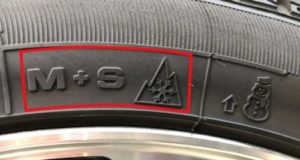
First, let’s start with the “M + S” stamp. This is an abbreviation for MUD + SNOW, which is often stamped on all-season tires, where “MUD” means mud or muddy, and “SNOW” means snow. It means a tire suitable for off-road driving.
It is important to distinguish whether it is a winter tire or not by the mountain and ice marks on the right side. This is the “snowflake mark“, and it is proof that the performance has been certified as a winter tire by the official test of ASTM International (former American Society for Testing and Materials). If the tire has this mark, it can be run even when the winter tires are regulated.
- Inspection required if used for more than 5 years. Replace at the right time
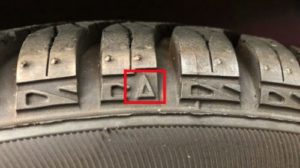
In order to use tires safely, we must pay attention to the following two changes. It is wear and aging. You can check the wear with the “slip sign“. First, there is a small △triangle mark on the tire shoulder (the tire shoulder, between the sidewall and the tread that contacts the road). There is a slip sign on this mark extension line, and it is a sign that it needs to be replaced if it is exposed. The limit of use due to tire wear is set at 1.6 mm in Article 167 of the Safety Standards of the Road Transport Vehicle Act(Japan based), and if it is less than that, it is not only dangerous, but it may also be a violation of the law. However, even before the slip sign is fully exposed, it is known that when the groove becomes about half, performance deterioration such as a decrease in grip and braking force begins. It is not required yet, better to replace .
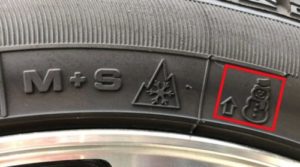
By the way, in the case of winter tires such as snow tires, in addition to the slip sign, there is a protrusion called “platform” in the tire groove. It is located on the extension of the arrow engraved on the side wall (the snowman mark is also engraved by some manufacturers) and is a mark to inform the limit of use as a winter tire. When the platform appears, it means that the tires have worn 50%, resulting in poor braking performance on ice and snow. If this happens, it cannot be used as a winter tire. It can be used as a summer tire until the above-mentioned exposure of the slip sign is confirmed, but its performance is decreasing even in the summer, so be sure to replace.
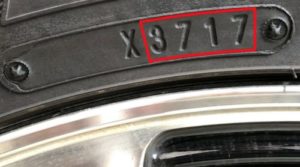
Tires not only wear due to mileage, but rubber deteriorates naturally over time. According to JATMA, tires over 5 years old need to be inspected. Tires are chemical products made of various materials such as rubber and cords (fiber yarns used in the framework of tires). Even with tires that have a short mileage and are not worn, there is a concern that they may crack due to aging deterioration and that grip strength may decrease due to aging hardening. The useful information for that is the year of manufacture of the tires stamped on the sidewall. The last two digits are the manufacturing year and the upper two digits are the manufacturing week. For example, “3717” means that it was manufactured at the 37th week of 2017 (September 11th to 17th). Unlike other stamps, the year of manufacture is stamped with a 4-digit number recessed in the rubber.
TIP1
By the way, if you check this information when choosing a used car, you can see that you may have replaced only one tire in the past. It is likely that there was some reason, such as an accident, that you would normally replace only one, so you may want to investigate carefully. In addition, the above-mentioned engraving corresponds to after 2000, and before 1999, it is represented by 3 digits (lower 1 digit: manufacturing year, upper 2 digits: manufacturing week). If your tire is engraved with 3 digits, it means that it’s been over 20 years old, so we recommend that you replace it immediately.

